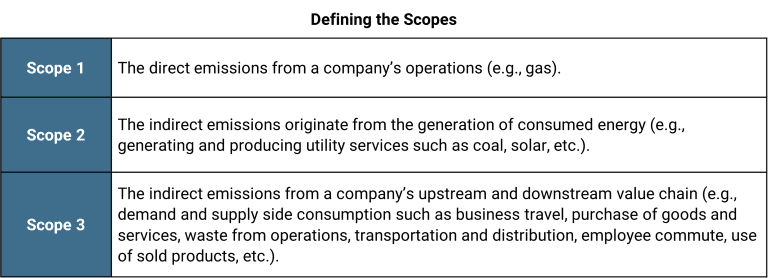Understanding Net Zero and the Need for a Standard Definition for Buildings

The increase in public and regulatory interest in climate risk and disclosures creates an opportunity for companies to set goals and auditable targets. Setting goals and auditable targets involves deploying the correct terminology to avoid ambiguity and clearly expressing an intention. For example, net-zero emissions at a company, portfolio, or building level are not calculated or achieved in the same manner. Globally, there is no standard industry agreed-upon definition of a net-zero building or what scopes to include. Given this confusion, this blog post intends to help explain net-zero and highlight potential gaps.
In 2021, the Science Based Targets Initiative (SBTi) released its Net Zero Standard, the first proposed global standard for science-based corporate net-zero target-setting. The SBTi standard includes Scopes 1, 2, and 3 (as defined by the Greenhouse Gas Protocol Corporate Accounting and Reporting Standard) and demonstrated alignment with a 1.5°C pathway. Net-zero for a company’s operations has more variables to consider than just the energy used by its buildings (e.g., travel, fleet, etc.). Companies consider what they directly emit (Scope 1) and what they induce others to emit (Scope 2) or their indirect emissions (Scope 3). It is important to consider what a company consumes in energy, how they produce it, and how the broader supplier ecosystem contributes. In addition, SBTi notes that a company must achieve its long-term science-based target to be considered net-zero (for most companies, this requires 90-95% emissions reduction by 2050 with the use of carbon removals for the remaining uneliminated emissions).

Source: Greenhouse Gas Protocol.
Achieving net-zero carbon (CO2) is different from overall net-zero emissions (GHG). Carbon dioxide is one component that is part of greenhouse gases (GHG), but there are others such as methane, nitrous oxide, etc. Sometimes this is referenced as CO2e (CO2 equivalent). Greenhouse gas uses other than CO2 may appear as methane usage or as a landscape contractor using nitrogen-rich fertilizers (i.e., nitrous oxide) when maintaining the building landscape. According to the Carbon Trust, carbon neutrality requires reductions only in Scope 1 and 2, and it is not mandated to reduce Scope 3 emissions.
On the other hand, an SBTi Net Zero Standard requires Scope 1, 2, and 3 globally for organizations. While CO2 emissions are a significant part of GHG, sometimes the terms are mistakenly used interchangeably. For example, suppose a building operates on 100% renewable energy and does not consume fossil fuels. In this instance, the building’s energy usage is considered zero carbon, which is different from claiming that the whole building is zero carbon (e.g., additional embodied carbon such as from tenant improvements/construction materials).
According to the Carbon Leadership Forum, GHG emissions associated with building materials used in construction from “manufacturing, transportation, use, and disposal” are considered embodied carbon. They regard extraction and production or up to the point of purchase (product stage from the building product lifecycle phases) as Scope 3. In addition, the end of life (disposal) and beyond (recycling) stages are also considered part of Scope 3 but typically omit the end of life (demolition). They also note, that of the two remaining stages of construction and usage (i.e., operations and repair), the operations stage fits in Scopes 1 and 2, leaving stages such as construction and demolition unclearly accounted for as either part of Scope 1, 2, or 3.
When setting a net-zero strategy and goals, it is essential to use the correct terminology so that stakeholders understand the potential outcomes. Many have understood a net-zero building as one that exclusively produces and/or consumes its required energy from renewable sources. Some may consider this a Net Zero-Energy building, while others use the term Net Zero Carbon building. It is important to consider the proper term when defining actions and goals, as one could suggest that a Net Zero Energy building definition resides around Scope 1 and 2. So should a Net Zero Carbon or Net Zero Emissions building include more than just energy from operations and include Scope 3 and/or embodied carbon (i.e., CO2 emissions from the construction process and materials through the lifecycle of a building) and all additional GHG areas? For example, will building owners and managers need to understand the actual embodied carbon not just for construction but the impact of cleaning, repairs, and maintenance during building use?
The UK Green Building Council outlines a framework for Net Zero Carbon Buildings that includes construction impacts (i.e., embodied carbon measurement), operational energy usage, increased renewable energy onsite, and an offsetting framework for the remaining carbon. Understanding how buildings and building operations contribute to emissions is a foundational step to knowing what levers are involved in making improvements. Buildings contribute to GHG in numerous ways, from energy consumption to building construction materials to the use of materials to maintain an existing building.
While a few industry organizations have developed their definition of net-zero for real estate, those are at the portfolio, company, or building levels. Some include Scope 3, and others do not. The unanswered question is: can the real estate industry align with the inclusion of Scope 3 and a net-zero definition? According to the World Green Building Council, Net Zero Carbon Buildings are broader than just energy usage concerns. They include reducing operational and embodied carbon emissions from the building and construction sectors. It considers the entire lifecycle impact of a building, and for existing buildings, this means energy reductions and future improvements. This definition would favor renovating existing buildings to impact embodied emissions but reducing energy consumption in older buildings can be more difficult due to outdated and inefficient infrastructure.
The Importance of Energy
The International Energy Agency (IEA) estimates that global buildings and building construction sectors account for 15% of direct CO2 emissions and one-third of energy consumption (electricity was one-third of building energy use in 2020). They also noted that by 2030 users must reduce energy consumed per square meter by 45% from 2020 levels to align to the 2050 Net Zero Emissions Scenario.
According to Architecture 2030, buildings contribute approximately 40% of annual global CO2 emissions, and of this amount, buildings operations contribute 28%, and construction and building materials contribute 11%. According to the UN Environmental Programme, the building sector contributes to all energy-related CO2 emissions by 38% (including building construction industry emissions).
Committing to Net Zero Carbon (CO2) Emissions or Net Zero Emission Buildings starts with understanding what areas of operations impact global greenhouse emissions. If buildings consume a third of all energy and contribute to roughly 40% of the CO2 emissions, and energy consumption needs to be reduced by 45% to 50% by 2030, where should real estate leaders focus? Especially if building operations contribute to 28% of these emissions, what levers are there to influence a reduction? Focusing on the building’s management, uses, and services is a place to start. Certainly, a plan to reduce energy consumption, electrification of the building (e.g., lower natural gas consumption), and purchasing or installing renewable energy sources are good actions. However, what about the indirect areas such as business travel, employee commute, etc.?
Final Thoughts
Energy is one of the highest costs to operate a building, including repairs & maintenance, equipment replacements, cleaning, and administration. All of which are impacted by the larger vendor/supplier ecosystem or embodied carbon. For example, if energy is roughly 30% of a building’s operating costs and the associated carbon must be reduced by 45% by 2030, can this target be accomplished through various operational actions and building improvements? Moving to 100% electrical consumption and locating in areas of the globe that use 100% clean energy can be difficult, prompting real estate leaders to shift their strategy and focus. Building energy consumption is typically made up of HVAC (e.g., ~30-50%), lighting (e.g., ~10-25%), equipment (e.g., ~10 to 20%) and elevators/lifts (e.g., ~5-10%) being the largest contributors. Leaders must shape their strategy and tactics to address these areas as they will greatly impact reducing energy consumption.
As you can see, the 2030 45% reduction becomes difficult without considering actions such as offsets, especially if energy production does not align with clean energy. Other essential focus areas for buildings to be sustainable include waste management, circular economy, energy-efficient equipment, green building materials, repairs & maintenance programs, and water consumption. Resiliency and the health & wellness of the operating and physical environments are also critical factors.
A net-zero-energy building is at equilibrium with the energy it produces and consumes from clean sources. A net-zero carbon building accounts for embodied carbon, which refers to the remaining CO2 emissions of construction and building materials. In line with these building definitions, must we evaluate whether we should include Scope 3 considerations in our definition of a net-zero (GHG) emissions building?
How would you define a net-zero (GHG) emissions building? How is your organization including Scope 3 in your reporting? Let us know your thoughts or feedback by filling out the form below!
By submitting the above form you consent to being contacted by BSI regarding your message.
References
- Retrieved on 2/5/2022 from https://sciencebasedtargets.org/net-zero
- Retrieved on 2/5/2022 https://www.carbontrust.com/resources/briefing-net-zero-for-corporates
- Retrieved on 3/26/2022 Targeting Net-Zero Embodied Carbon – Carbon Leadership Forum
- Retrieved on 2/5/2022 https://www.ukgbc.org/wp-content/uploads/2019/04/Net-Zero-Carbon-Buildings-A-framework-definition.pdf
- Retrieved on 2/5/2022 from https://www.worldgbc.org/thecommitment
- Retrieved on 2/5/2022 from https://www.iea.org/topics/buildings
- Retrieved on 2/5/2022 from https://www.iea.org/reports/tracking-buildings-2021
- Retrieved on 2/5/2022 from https://architecture2030.org/why-the-building-sector/#:~:text=Buildings%20generate%20nearly%2040%25%20of,for%20an%20additional%2011%25%20annually
- Retrieved on 2/5/2022 from https://www.unep.org/news-and-stories/press-release/building-sector-emissions-hit-record-high-low-carbon-pandemic
- https://www.ghgprotocol.org/sites/default/files/ghgp/standards_supporting/Diagram %20of%20scopes%20and%20emissions%20across%20the%20value%20chain.pdf

